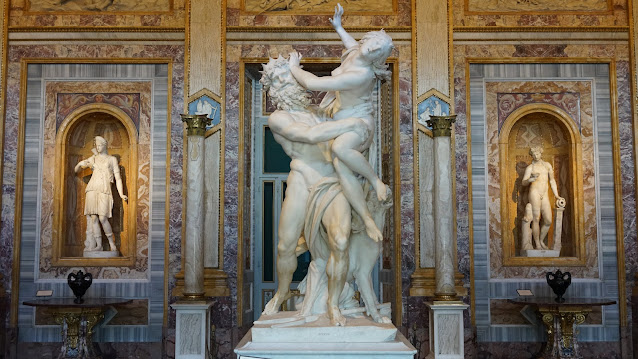Pluto and Proserpina (or The Rape of Proserpina)
For this blog I’d like to first talk about my choice in
artist. Gian Lorenzo Bernini, an Italian artist who developed a deep love and influence
within Greek and Roman marble sculptures during his early years. First beginning
his career studying under his father, Pietro Bernini, a talented sculptor who
ultimately moved to Rome (Howard, 2021). Gian Lorenzo Bernini achieved fame
early on, praise given from both elevated society within Rome as well as other
painters and artist. Most importantly, Bernini was heavily influenced by his
strong Roman Catholicism. He thoroughly agreed with the Council of Trent, art should
be realistic and emotional in that it should strike inspiration in the faithful
and serve the Roman Catholic Church (Howard, 2021). The piece I have chosen of
Bernini’s for the Baroque Blog will only highlight his talent and attention to
detail in his goals to make sculptures that are eerily realistic and emotional
in presentation. However, contrary to his deep religion, this piece is solely a
reflection of Greek Mythology, speaking of Bernini’s inspiration and fascination
rather than beliefs.
Look at the sculpture from different angles, the arch to
Pluto’s foot, Persephone’s angle of torso, the placement of arms and legs of
both individuals, this sculpture is the depiction of movement. A single moment
caught in stone. Bernini truly captures an incredibly unstable stance, for both
individuals. The push and pull of both individuals, the emotion clearly
captivated within the faces, as well as the addition of Cerberus, Hade’s guard
dog in the bottom corner below Persephone. All in motion.
The emotion behind this sculpture is one of devastation and desperation.
Though it may be a tough topic to consider, this art depicts the act of
possession, specifically a possession without consent. Rape. Pluto being one of
the higher arching members of Greek mythology, clearly holds the upper hand in
both strength and power regarding Persephone. Even Hades would have a terrible
time attempting to match Pluto. Not only in power, prestige, and overall physical
strength, Persephone’s expression shows one of struggle and impending hurt. Bernini
captures the glee of triumph upon Pluto’s face, and the overall devastation of
Persephone’s. The smirk upon Pluto’s face has a knowing look of triumph as he
too may realize that he lacks any competition in this want.
The subject behind this sculpture is truly haunting, however,
the skill and ability with which this sculpture has been made is truly a piece
of wonder. I had to put aside my general lack of disgust for the act with which
Bernini captured and focus on the details of which he was able to display through
such a difficult type of sculpting.
Hibbard, Howard.
"Gian Lorenzo Bernini". Encyclopedia Britannica, 8 Dec. 2021, https://www.britannica.com/biography/Gian-Lorenzo-Bernini.
Accessed 11 October 2022.
Dr. Steven Zucker
and Dr. Beth Harris, "Gian Lorenzo Bernini, Pluto and Proserpina (or The
Rape of Proserpina)," in Smarthistory, November 27, 2015, accessed October
11, 2022, https://smarthistory.org/bernini-pluto-and-proserpina/.







Comments
Post a Comment